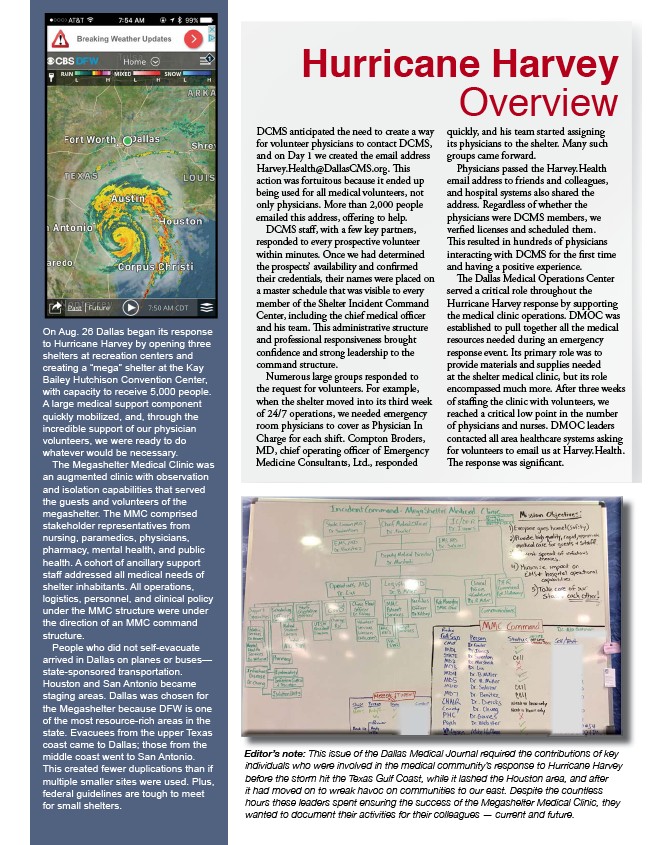
Hurricane Harvey
Overview DCMS anticipated the need to create a way
quickly, and his team started assigning
for volunteer physicians to contact DCMS,
its physicians to the shelter. Many such
and on Day 1 we created the email address
groups came forward.
Harvey.Health@DallasCMS.org. Th is
Physicians passed the Harvey.Health
action was fortuitous because it ended up
email address to friends and colleagues,
being used for all medical volunteers, not
and hospital systems also shared the
only physicians. More than 2,000 people
address. Regardless of whether the
emailed this address, off ering to help.
physicians were DCMS members, we
DCMS staff , with a few key partners,
verfi ed licenses and scheduled them.
responded to every prospective volunteer
Th is resulted in hundreds of physicians
within minutes. Once we had determined
interacting with DCMS for the fi rst time
the prospects’ availability and confi rmed
and having a positive experience.
their credentials, their names were placed on
Th e Dallas Medical Operations Center
a master schedule that was visible to every
served a critical role throughout the
member of the Shelter Incident Command
Hurricane Harvey response by supporting
Center, including the chief medical offi cer
the medical clinic operations. DMOC was
and his team. Th is administrative structure
established to pull together all the medical
and professional responsiveness brought
resources needed during an emergency
confi dence and strong leadership to the
response event. Its primary role was to
command structure.
provide materials and supplies needed
Numerous large groups responded to
at the shelter medical clinic, but its role
the request for volunteers. For example,
encompassed much more. After three weeks
when the shelter moved into its third week
of staffi ng the clinic with volunteers, we
of 24/7 operations, we needed emergency
reached a critical low point in the number
room physicians to cover as Physician In
of physicians and nurses. DMOC leaders
Charge for each shift. Compton Broders,
contacted all area healthcare systems asking
MD, chief operating offi cer of Emergency
for volunteers to email us at Harvey.Health.
Medicine Consultants, Ltd., responded
Th e response was signifi cant.
Editor’s note: This issue of the Dallas Medical Journal required the contributions of key
individuals who were involved in the medical community’s response to Hurricane Harvey
before the storm hit the Texas Gulf Coast, while it lashed the Houston area, and after
it had moved on to wreak havoc on communities to our east. Despite the countless
hours these leaders spent ensuring the success of the Megashelter Medical Clinic, they
wanted to document their activities for their colleagues — current and future.
On Aug. 26 Dallas began its response
to Hurricane Harvey by opening three
shelters at recreation centers and
creating a “mega” shelter at the Kay
Bailey Hutchison Convention Center,
with capacity to receive 5,000 people.
A large medical support component
quickly mobilized, and, through the
incredible support of our physician
volunteers, we were ready to do
whatever would be necessary.
The Megashelter Medical Clinic was
an augmented clinic with observation
and isolation capabilities that served
the guests and volunteers of the
megashelter. The MMC comprised
stakeholder representatives from
nursing, paramedics, physicians,
pharmacy, mental health, and public
health. A cohort of ancillary support
staff addressed all medical needs of
shelter inhabitants. All operations,
logistics, personnel, and clinical policy
under the MMC structure were under
the direction of an MMC command
structure.
People who did not self-evacuate
arrived in Dallas on planes or buses—
state-sponsored transportation.
Houston and San Antonio became
staging areas. Dallas was chosen for
the Megashelter because DFW is one
of the most resource-rich areas in the
state. Evacuees from the upper Texas
coast came to Dallas; those from the
middle coast went to San Antonio.
This created fewer duplications than if
multiple smaller sites were used. Plus,
federal guidelines are tough to meet
for small shelters.